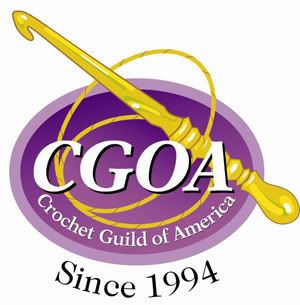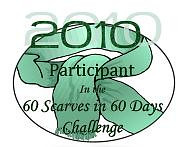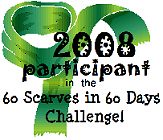No Sheep for You - book review
No Sheep for You: Knit happy with cotton, silk, linen, hemp, bamboo & other delights; by Amy R. Singer. Interweave Press, Loveland, CO, 2006
Over all this is not a crochet book, it's all about how these fibers knit up, and all the patterns are knit. But the book is loaded with information that we can apply to our crocheting.
First, there's information about different fibers; where they come from, how they're processed, what that does as far as strength, shine and dyability (that's a fun word). Then there's some history of different fibers.
Here are some of the natural fibers that I've already tried: hemp, cotton, cotton/milk fiber, cotton/soy blend, soy/acrylic blend, rayon, bamboo,and bamboo/acrylic blend. Some of the synthetic fibers: acrylic, nylon, polyester and spandex.
Some of the fibers featured that I haven't tried yet (they're on my list!) include: corn, lyocell - one brand name is Tencel (wood), Modal (wood from the beech tree), and Seacell (lycocell and algae!).
There's a great chart with the "Fiber Families" and some characteristics, such as stretch, how it feels on the needles and after washing, care, shrinkage and blocking. Another great chart has some fiber properties (such as elasticity) and ranks the fibers from the most to the least. The next chart is how to choose your fiber depending on the wool characteristic you're looking for; for example, if you're looking for the softness of wool - select "...something loosely spun; look for silk, a silk blend, or bamboo. If you're looking for stitch definition - "pick a smooth, tightly spun yarn; knit it snugly". The information in these beginning chapters and the charts will help you select a wool yarn substitute that will work for your project.
Chapter 3, which is about swatches and swatching, without calling them that is worth the price of the book. Even if you never look at any of the patterns, you will have gotten your money's worth. But,...look at the patterns, you don't have to knit any of the pieces, but the abundant schematics on the sweaters will be tremendously helpful when you select your perfect non-wool fiber and start to crochet!
Scattered among the patterns are snippets of useful information like "Why does yarn shrink?" "Why does yarn pill?" "The Myth of the center-pull ball", and the important "Are you really allergic to wool?". The author has gone to an allergist, who explains why some people might get the "itchies" from the scratchy fibers, why some people might react to something on the wool such as lanolin, soaps or dyes; and what you can do about some of these mild to medium "sensitivities"; but she also gives information about true allergic reactions when the immune system kicks in, and the best choice is to avoid the fiber.
I noticed that I first mentioned this book in a blog entry in August, 2007 with a note that I added it to my Christmas wish list. Well, Christmas and my birthday, have come and gone, and I'm still checking the book out of the library. It might be something that I just "have" to buy at the conference.

















0 Comments:
Post a Comment
<< Home